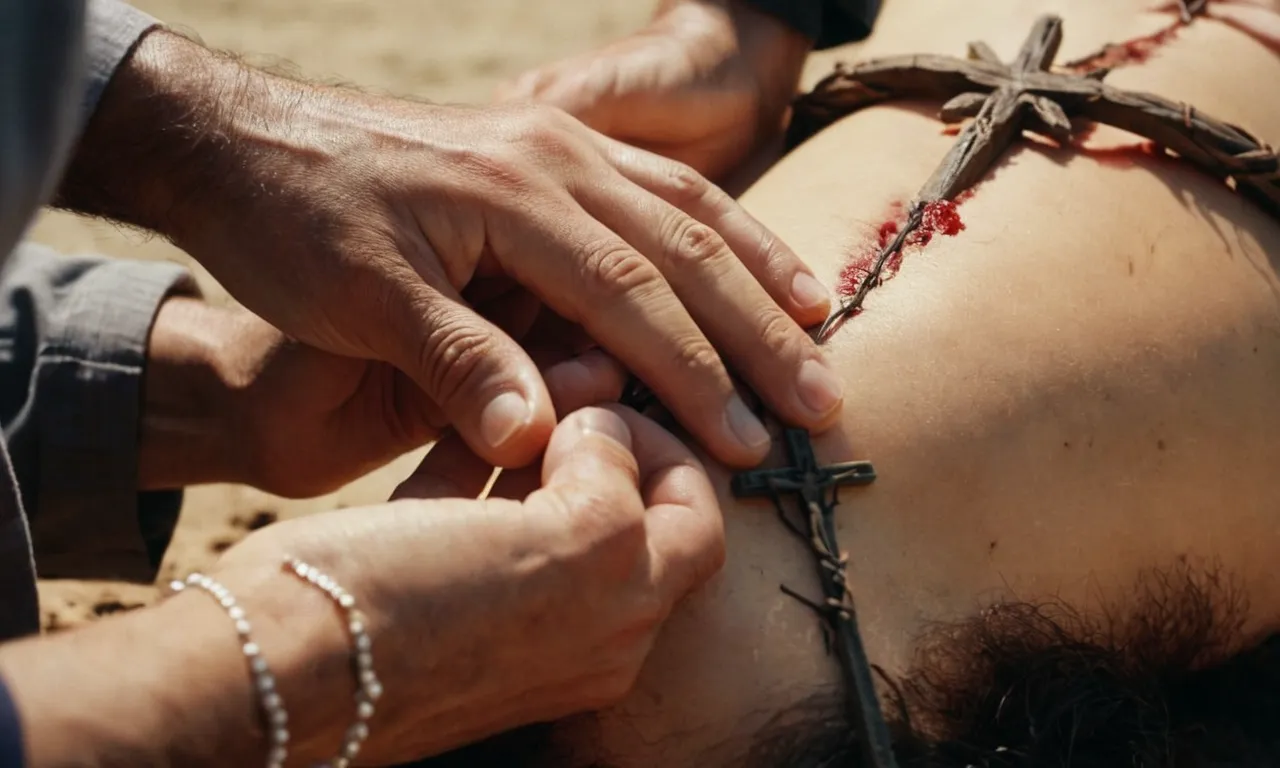Who Took Jesus Off The Cross?
The crucifixion of Jesus Christ is one of the most pivotal events in human history. Christians believe that Jesus willingly sacrificed himself on the cross to atone for the sins of humankind.
After Jesus died on the cross, his lifeless body had to be taken down and prepared for burial.
But who took Jesus’ body off the cross after his death? If you’re short on time, here’s a quick answer: According to the Bible, a man named Joseph of Arimathea took Jesus’ body off the cross with permission from Pontius Pilate. He then prepared the body and placed it in his tomb.
In this comprehensive article, we will examine the biblical accounts of Jesus’ crucifixion and burial in detail.
We will look at what the Gospels say about who took Jesus off the cross, as well as some of the historical and cultural context around crucifixion and burial practices in first-century Judea.
The Gospel Accounts of Jesus’ Crucifixion
Jesus’ Death on the Cross
The four Gospels in the New Testament provide eyewitness accounts of the crucifixion of Jesus Christ around 30-33 AD.
According to the Gospels, Jesus was sentenced to death by Pontius Pilate, the Roman prefect of Judea, for claiming to be the Son of God.
After being flogged and mocked by soldiers, Jesus carried his cross to Calvary where he was nailed to the wooden cross between two criminals (Matthew 27:32-44, Mark 15:21-32, Luke 23:26-43, John 19:17-27).
As Jesus hung on the cross in agony, he spoke several times, forgiving the soldiers, promising Paradise to one of the criminals, and entrusting his mother Mary to the apostle John.
In the synoptic Gospels, darkness covered the land for three hours as Jesus cried out “My God, my God, why have you forsaken me?”
(Matthew 27:45-46, Mark 15:33-34, Luke 23:44-46). John’s account records Jesus saying “I am thirsty” and then declaring “It is finished” before giving up his spirit (John 19:28-30). This signifies that Jesus willingly sacrificed his life to atone for the sins of humanity.
Taking Down the Body
According to the Gospels, Jesus died on the cross sometime in the afternoon on Preparation Day before the Sabbath (Matthew 27:57, Mark 15:42, Luke 23:54, John 19:31). Jewish leaders asked Pilate to hasten the deaths of Jesus and the criminals so their bodies would not remain on the crosses during the Sabbath.
To ensure Jesus was dead, a Roman soldier pierced his side with a spear causing blood and water to flow out (John 19:31-34).
In the evening, Joseph of Arimathea, a wealthy Jewish follower of Jesus, went boldly to Pilate to request Jesus’ body.
With Pilate’s permission, he took down Jesus’ body and wrapped it in a linen cloth along with myrrh and aloes according to Jewish burial customs.
Assisted by Nicodemus, another secret follower, Joseph placed the body in a new rock-hewn tomb in a garden near the site of the crucifixion before the Sabbath began at sunset (Matthew 27:57-61, Mark 15:42-47, Luke 23:50-56, John 19:38-42).
The Gospel writers took care to report that Jesus was truly dead and buried, with eyewitnesses verifying his tomb. This lends historical credibility to the astonishing event that occurs next – the resurrection.
On the third day after his crucifixion, the tomb was found empty and Jesus began appearing to his disciples, proving that he had conquered sin and death once for all (Matthew 28, Mark 16, Luke 24, John 20).
Who Was Joseph of Arimathea?
His Background and Status
Joseph of Arimathea was a wealthy, prominent member of the Jewish Sanhedrin who came from the Judean town of Arimathea.
According to the Gospels, Joseph was a good and righteous man who was a secret follower of Jesus due to fear of persecution from other Jewish leaders.
He did not consent to the Sanhedrin condemning Jesus to death.
As a member of the Sanhedrin, the Jewish high court, Joseph of Arimathea had status and influence. His wealth is evidenced by the fact that he owned a rock-cut tomb in a garden near Golgotha.
At the time, such a burial place would have been expensive and signify Joseph’s material means.
His Request to Pilate
After Jesus died on the cross on Friday afternoon, Joseph gathered the courage to go to Pontius Pilate and ask for Jesus’ body so he could give Him an honorable burial.
This was a risky move since publicly showing allegiance to the condemned Jesus could make him a target of scrutiny from the Sanhedrin council and the Roman prefect.
However, as Mark 15:43 states “Joseph of Arimathea, a prominent Council member who himself looked forward to the coming of God’s kingdom, boldly went to Pilate and asked for Jesus’ body.” Pilate consented to give Jesus’ body to Joseph.
Preparing and Burying Jesus’ Body
After receiving permission from Pilate, Joseph, along with Nicodemus, took Jesus’ body from the cross and wrapped it with spices in long strips of linen cloth according to Jewish custom.
Since it was near sunset on Preparation day before the Sabbath when no work could be done, they laid Jesus in Joseph’s nearby rock-hewn tomb.
Though we don’t know exactly who took Jesus off the cross itself since the Gospels don’t specify, clearly Joseph of Arimathea and Nicodemus were the first to handle Jesus’ body with honor after the crucifixion, lovingly preparing His battered body for burial according to Jewish practice at the time.
The Significance of Jesus’ Burial
Fulfillment of Scripture
Jesus’ burial is significant because it fulfilled Old Testament prophecies about the Messiah. Isaiah 53:9 states that the Suffering Servant (interpreted by Christians as the Messiah) would be assigned a grave with the wicked but would actually be buried with the rich.
This prophecy was fulfilled when Jesus, who was crucified between two criminals, was buried in the tomb of Joseph of Arimathea, a wealthy member of the Sanhedrin (Mark 15:43-46).
Another prophecy potentially fulfilled is Psalm 16:10, which states that God’s Holy One would not remain in the realm of the dead or allow His body to decay.
The Gospels record that Jesus was buried on Friday afternoon and rose on Sunday morning, meaning His body did not have time to decompose in the tomb (Matthew 28:1-10).
This points to Jesus’ power over death and His divinity.
Validation of Jesus’ Death
The burial of Jesus also serves to validate His physical death by crucifixion. Some critics over the years have claimed that Jesus did not actually die on the cross.
However, the fact that His lifeless body was prepared for burial and laid in a tomb is evidence that He had truly died.
The Roman soldiers who crucified Jesus would not have taken His body down while any life remained (John 19:31-34).
In addition, the discovery of Jesus’ empty tomb on Sunday morning points to His resurrection from actual death. If He had not died, there would have been no need for God to raise Him back to life.
The women and disciples who went to the tomb fully expected to find Jesus’ dead body there, confirming that they knew He was deceased (Mark 16:1, Luke 24:1-3).
So in short, Jesus’ proper Jewish burial signifies the fulfillment of prophecy about the Messiah as well as serving as proof of His physical death on the cross, without which there could be no resurrection.

Burial Practices in First Century Judea
Jewish Customs
In first century Judea, Jewish burial customs were shaped by Biblical laws and rabbinic interpretations. According to Jewish law, the deceased must be buried as soon as possible, usually within 24 hours. This was seen as a sign of respect for the dead.
The body would be washed and anointed with perfumed oils and spices before being wrapped in linen cloths.
Family members and friends would mourn for seven days, known as shiva, by covering mirrors, sitting on low stools, and wearing torn clothes.
On the seventh day, mourners would walk around the neighborhood to announce the end of shiva.
Burial required a shroud and coffin at minimum. Wealthier families used stone ossuaries to store the bones after the body decomposed.
The ossuaries were decorated with carvings and inscriptions. Jewish cemeteries were located outside the city limits.
The body was placed in a cave or trench grave with no coffin. Sometimes niches were carved into walls for bodies. The graves were marked with stone, clay, or wood monuments. Jewish law prohibited cremation and the use of coffin ornaments.
Roman Crucifixion and Burial Norms
In contrast, Roman laws granted little dignity to crucifixion victims. Crucifixion was reserved for slaves, rebels, and the worst criminals.
The shameful public deaths were meant to deter dissent. Bodies were often left on crosses to be devoured by animals.
Romans saw denial of burial as the ultimate humiliation.
If allowed, families could take bodies for burial according to local customs. Wealthy families might hold memorial meals at the tomb.
Most victims were dumped in common graves or pits. However, some were placed in niches carved into rock walls of necropolises outside the city.
Grave goods and offerings were uncommon. Elite Romans practiced cremation, but this was rare for crucifixion victims since most were from lower classes.
Later Traditions About Taking Down Jesus’ Body
The Gospel of Peter
The Gospel of Peter, an apocryphal gospel probably written in the 2nd century AD, contains an account of Jesus’ burial and resurrection that differs from the canonical gospels.
According to the Gospel of Peter, after Jesus died on the cross, the Jews handed his body over to the Romans to be buried.
However, none of Jesus’ disciples are mentioned as taking part in burying his body.
Instead, the Gospel of Peter states that after Jesus died, the Jews “began to cry out exceedingly, and to say: Woe on our sins! For judgment is drawing nigh, and the end of Jerusalem.”
The Jewish leaders then handed Jesus’ body over to the Romans, asking Pilate to guard the tomb: “And they took the Lord and pushed him in haste, and the door of the sepulchre they closed and sealed with a stone.”
The Gospel of Peter later describes Jesus’ resurrection, stating that Jewish leaders, elders, and scribes went to the tomb on Sunday morning.
When they saw the opened tomb, “they saw there three men come out of the sepulchre, two of them sustaining the other, and a cross following, after them.”
This appears to be the first written account of angels/men at Jesus’ empty tomb.
Other Extra-Biblical Accounts
A few other ancient Christian writings outside the New Testament mention Jesus’ burial and resurrection, though usually only briefly:
- The Gospel of Nicodemus (also called the Acts of Pilate), an apocryphal gospel from the 4th or 5th century AD, retells the trial and death of Jesus, including his burial by Joseph of Arimathea and resurrection.
- A letter by Ignatius from around 110 AD alludes to Jesus being buried and rising again.
- Justin Martyr’s Dialogue with Trypho from the mid-2nd century AD references Jesus being buried and rising on the third day.
- The late 2nd century apocryphal Acts of John briefly mentions those who buried Jesus.
However, these brief references generally agree with the outline of the canonical accounts without adding significant new traditions about those who took Jesus down from the cross.
By the late 2nd century, the basic tradition of Joseph and Nicodemus burying Jesus seems well established.
Conclusion
In the Gospel accounts, Joseph of Arimathea took responsibility for taking Jesus’ body off the cross and giving him an honorable burial according to Jewish customs, with permission from Pontius Pilate.
Though some later traditions emerged about others participating in taking down or handling Jesus’ body, the biblical record shows that Joseph played the primary role in caring for Jesus’ body after his crucifixion.
Jesus’ quick burial fulfilled Old Testament prophecies and gave evidence that he was truly dead. Just as Jesus willingly gave up his life on the cross, someone had to willingly take his lifeless body down from the instrument of death to prepare it for burial.
Joseph of Arimathea courageously undertook this solemn task, making sure that Jesus’ sacrifice was honored.








